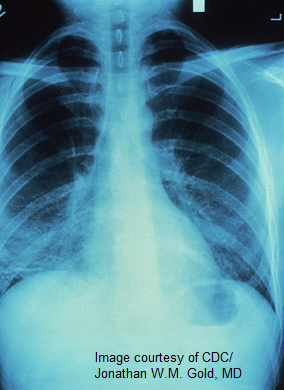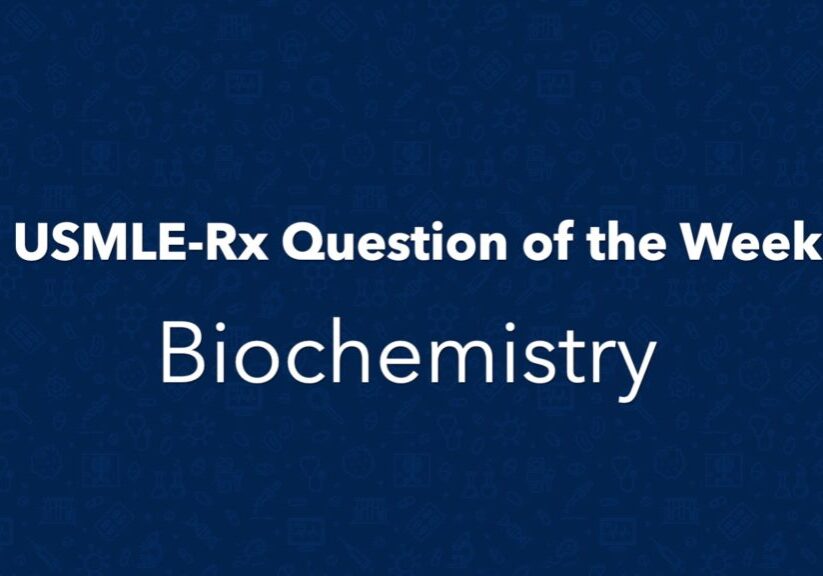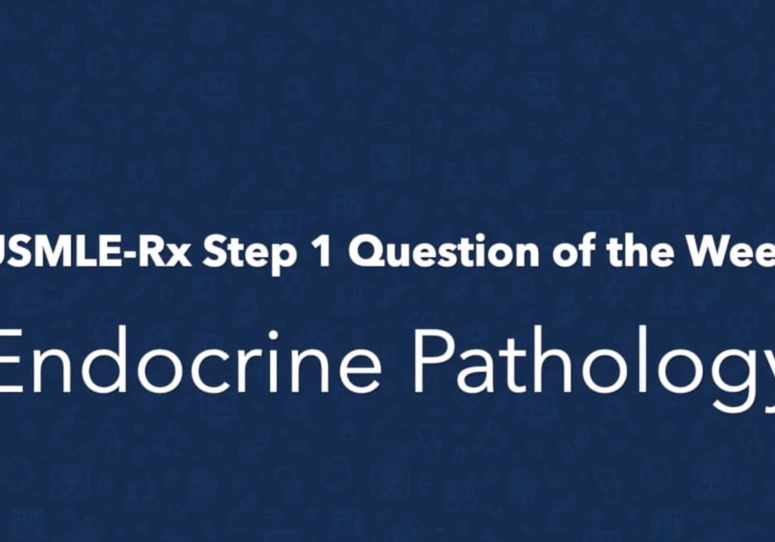Check out today’s Step 1 Qmax Question Challenge.
Know the answer? Post it below! Don’t forget to check back for an update with the correct answer and explanation (we’ll post it in the comments section below).
 A 32-year-old woman complains of a 1-month history of weight loss, fever, cough, and difficulty breathing. Physical examination reveals cervical lymphadenopathy and bilateral decreased breath sounds, as well as white patches on her tongue and buccal mucosa. The patient’s chest X-ray is shown here. The physician prescribes trimethoprim-sulfamethoxazole.
A 32-year-old woman complains of a 1-month history of weight loss, fever, cough, and difficulty breathing. Physical examination reveals cervical lymphadenopathy and bilateral decreased breath sounds, as well as white patches on her tongue and buccal mucosa. The patient’s chest X-ray is shown here. The physician prescribes trimethoprim-sulfamethoxazole.
Which of the following laboratory techniques should be utilized to confirm the cause of the patient’s susceptibility to the current infection?
A. Immunoassay
B. Northern blot
C. Polymerase chain reaction
D. Restriction fragment length polymorphism
E. Southern blot
———————–
Want to know the ‘bottom line?’ Purchase a USMLE-Rx Subscription and get many more features, more questions, and passages from First Aid, including images, references, and other facts relevant to this question.
This practice question is an actual question from the USMLE-Rx Step 1 test bank. For more USMLE Step 1 prep, subscribe to our Flash Facts and Step 1 Express video series. Score the best deal on all three products with a Step 1 Triple Play Bundle.




c
PCR
A
I think….
This is a case of Atypical Fungal-caused Pneumonia and the cause of the Susceptibility to the current infection is HIV. So Western Blotting is the confirmatory procedure for HIV proteins.
I believe this patient is infected with. HIV So A refers to western blot. I had to review again.
The correct answer is A. This woman has signs and symptoms of HIV infection, given the descriptions of oral thrush, weight loss, lymphadenopathy, and Pneumocystis jirovecii infection (evidenced by the interstitial infiltrates on the X-ray). Thus, we need to determine which technique confirms a positive HIV status.
Previous (2004) CDC HIV testing guidelines recommended the use of Western blot and immunofluorescence assays to detect infection. The current (2014) CDC algorithm recommends the validation of HIV infection with “fourth-generation” immunoassays that are more specific and produce fewer indeterminate results. In these fourth-generation immunoassays, HIV antibodies in a positive blood specimen from an infected patient bind to HIV antigens on a substrate and to antigens conjugated to indicator molecules; in doing so, the immunoassays test for the the presence of HIV-1 and HIV-2 antibodies and HIV-1 p24 antigen. Testing for the p24 antigen enables the detection of HIV-1 infection before seroconversion, as levels of p24 rise before those of anti-HIV antibodies. Positive blood specimens are subjected to more specific immunoassays, which distinguish among HIV-1, HIV-2, and acute HIV-1 infections. This procedure will be used to reveal the patient’s HIV status and the strain of virus.
B is not correct. Northern blotting is a technique that measures gene expression by indentifying RNA in a given sample. There are complementary DNA probes that hybridize to unidentified RNA molecules after the RNA sample of interest is cut by restriction enzymes and then run on gel electrophoresis.
C is not correct. Polymerase chain reaction (PCR) is a technique by which a short DNA or RNA sequence is amplified enormously by the use of primers and polymerase enzymes, with further DNA synthesis occurring in repeated cycles. Although PCR may be used as part of this procedure, it can neither specify the HIV virus nor confirm its presence. Current HIV testing includes a series of immunoassays. The initial immunoassay tests for the the presence of HIV-1 and HIV-2 antibodies and HIV-1 p24 antigen in a blood specimen from the patient.
D is not correct. A restriction fragment length polymorphism technique detects a polymorphic difference in DNA sequences between individuals that can be recognized by restriction endonuclease. It is not a technique used in the detection of a protein.
E is not correct. Southern blotting is a standard method for analyzing the structure of DNA cleaved by restriction enzymes, but is not used for detecting HIV.
Thanks for the explanation .
Wait guys; the question is asking “to confirm” which should be “Western blot”. Immunoassay is NOT Western blot. Immunoassay is “Best initial test”. There must be some mistake with the “wording” of the question.